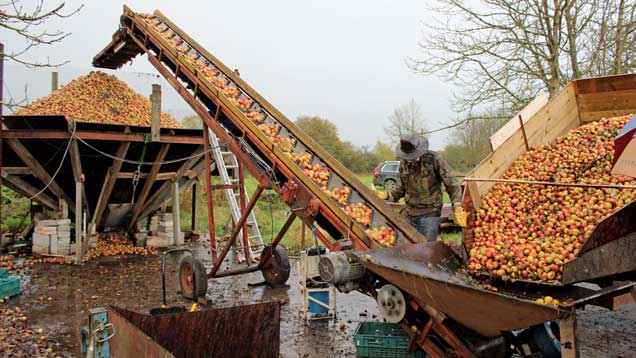Unusual harvesters: Cider apples

The cider apple is currently one of the UK’s most profitable crops.
While wheat prices wane and blackgrass starting to bully traditional crops out of previously productive land, apple growers are exploiting a growing world market for cider.
The south west of England has the perfect climate for apple trees and, with 3,300ha of new orchards planted in the past decade, we now produce about 60% of Europe’s cider apples.
Export markets reach as far as Japan and Australia, where punters crave the high flavour and moderate alcohol levels produced by British makers.
See also: South American sugar cane harvesters
Planting
Like most industries, apple growers have been hit by the rising cost of labour. Thirty years ago and a grower could have a reasonable stab at an orchard business on 15ha, but you’d need closer to 40ha to pay the bills these days.
Establishment costs aren’t for the fainthearted, either – you’ll have to scribble a cheque for £5,000 just to get an acre-sized plot drained and planted. Add another £1,200 over the next three years and you’ll be getting closer to producing a half-decent crop.
However, growers can confidently budget for a productive life of anything from 20 years to beyond 40, according to Robert Fovargue of top fruit specialist Pearce Seeds. He reckons outlay costs are usually recovered at year seven, by which time the crop should be producing boughs dripping with fruit.
Production
“Growers that pour on the fertiliser will often be rewarded with good yields,” says Mr Fovargue.
“However, it’s worth bearing in mind that at £110/t the cider apple is pretty low value compared with a £450/t eating apple crop. So, generally, the idea is to keep input costs to a minimum.”
Nitrogen, potassium and magnesium is applied little and often to maximise uptake and minimise leaching. The more promising the crop is looking through summer, the more fertiliser it is treated to, says Mr Fovargue.
Average growers are likely to produce around 36t/ha, while those on top-notch, grade 1 soil might comfortably rake in over 45t/ha.
Yields vary according to the variety, just like any mainstream arable crop. There are currently around 20 varieties grown by commercial producers, who use the different harvest times of each to stagger the production of fruit.
Harvesting
The harvest season usually starts in early September and certain varieties carry fruit through until mid-December.
Smaller growers use hand-pushed machines to gather crops, but a majority of the bigger producers use self-propelled harvesters. Most stay on farms for a long time because the initial outlay is pretty steep, which means the annual market only supports about 15 units.
Tractor mounted shaking machines are also an important part of harvest. These clamp their pincers around the trunk and shake it vigorously, sending a shower of apples to the deck. And, while most buyers would turn their nose up at a battered and bruised Granny Smith, it’s not an issue for cider crops because they are pressed as soon as they reach the mill.
Premium prices
Buyers are increasingly prepared to pay a premium for cleaner fruit with a higher sugar level and low starch.
However, base price remains on tonnage produced, and growers agree contracts with cider makers that sometimes run for 25 years.
There are at least six major producers in the UK, including household names Bulmers, Magners and Thatchers. In total they produce 130m gallons of cider, which keeps demand high and prices strong.
Tuthill Temperley
The Satsuma-liveried Tuthill Temperley is a one-pass harvester that mounts to a small orchard-style tractor to chomp its way through 90t/day.
Tuthill Temperley Centipede
Power Mounts to a 50hp tractor
Travel speed 3kph
Output 90t/day
Cost £70,000
Leading the way are linkage-mounted front brushes to fling fruit out of the tractor’s path. A mid-mounted head sweep then reaches out to claw the crop from alongside and in-between the trees, with a lightly inflated tyre protecting the metalwork from uncompromising trunks.
The pick-up feeds a crop elevator that sits on a powered and steered rear axle. It takes the apples to a hedgehog cleaner belt and 710mm fan that clears out any grass, leaf and debris, before it is dropped into a high-sided trailer.
Power comes from the tractor pto, which powers the Centipede’s own hydraulic system. All the functions are then managed through an electric control box in the cab.
Pattenden Grouse
The Ledbury-built Pattenden Grouse is altogether smaller than the Tuthill Temperley and comes in at half the price.
Pattenden Grouse
Power 35hp Yanmar engine
Travel speed 6kph
Output 40t/day
Cost £36,000
Motive power is provided by a 35hp Yanmar engine, which runs a hydrostatic drive to all three wheels. Each wheel can also be steered, so operators can crab the Grouse to poke the nose of the machine close to the tree line while keeping the cab and hopper clear of the branches.
The Grouse storms along rows at 6kph, with the hydraulically driven front paddle whizzing around and pushing apples into the pick-up’s path using rubber flaps.
The fruit is then cleaned and shifted via an auger to the 500kg hopper on the back. Once it’s full it can be hoisted 2.5m in the air to tip into a big 14t trailer waiting at the edge of the orchard.
Buyers need to be harvesting at least 500t/year to justify the cost. If you’re producing more then you might want the Falcon – a 100t+/day harvester carrying a 2t basket and powered by a John Deere engine.



